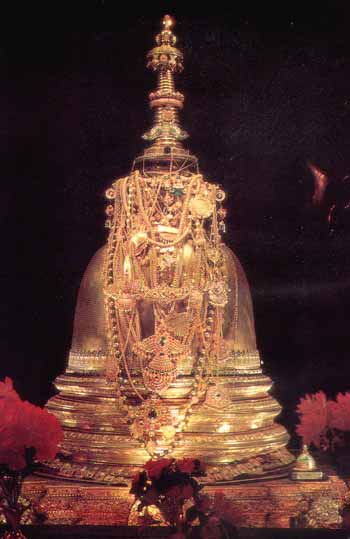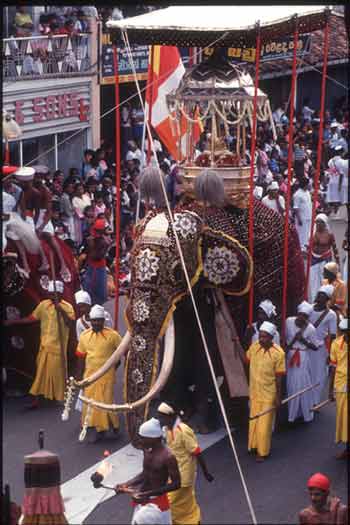
|
||||||||||
|
| ||||||||||
Sacred Tooth Relic and the Esala Perahera
by Walter WijenayakeThe most spectacular Buddhist festival of the year, the historic Kandy Esala Perahera of the Sri Dalada Maligawa commenced on 27th July 2009, with the Kumbal Perahera and comes to a conclusion on the August 5th with the final Randoli Perahera. The day Perahera will be on the 6th with the water cutting ceremony (Diya Kepeeme Mangalya) at the Gatembe ferry. The big news this year concerns the extension of the route of the Kumbal Perahera. It started from the Maligawa Square and proceeded along Dalada Veediya. D.S. Senanayake Veediya (Trincomalee street), Pansala Para, Deva Veediya, Srimath Bennet Soysa Veediya, Kotugodella Veediya, Raja Veediya and back to Maligawa Square. With the planting of the Kap, the inner Perahera commenced on the 22nd by parading within the Sri Dalada Maligawa Complex and continued till 26th before it took to the streets with the Kumbal Perahera. The perahera festival - an event of great historical and cultural significance - takes place annually in the charming hill capital of the country in the month of July/August. This event, known the world over as the Kandy Esala perahera, is not only a religious ritual but also a folk festival which provides an occasion for local artistes and multi-racial populace to exhibit their reverence and devotion to the Buddha and Gods and Goddesses such as Natha, Vishnu, Kataragama and Pattini who with their divine blessings protect this country. The Sacred Tooth Relic of the Buddha was brought to this island in the reign of King Kirthi Sri Meghavanna (303-331), as an invaluable gift of the King of Kalinga (Orissa in India). Since the day it was brought here, it has been the custom of the devotees to celebrate this great event with the highest esteem and reverence. However, the Sacred Tooth Relic was never enshrined in a Dagaba, unlike other relics, but always remained a movable revered object devoutly venerated by the Buddhists all over the world. Whatever it is, it had to be buried in the earth once at Kotmale to save it from the enemies. The King enshrined the Sacred Tooth Relic in a pure crystal bowl and placed it at Abhayagiriya Viharaya in Anuradhapura, the Kingdom of King Kirthi Sri Moghawanna, for public worship. It is recorded in the history that the Dalada Perahera came into being during this King in his kingdom. Furthermore, the Abhayagiri Viharaya undertook to conduct annually the Perahera. The Maha Viharaya, Abhayagiri Viharaya and Jethavanarama Maha Viharaya were the three main places of worship when King Kirthi Sri Megavanna was reigning Anuradhapura. The three places were known as thun nikaya (three nikayas). Fa Hien, the Chinese traveller who visited Anuradhapura, in his writings has described the ceremony of the Sacred Tooth Relic which was conducted with great splendour. When Cholians conquered Anuradhapura in 1017 the devout Buddhist Bhikkus had to shift the Sacred Tooth Relic to Rahula for safety. Again it was brought to Polonnaruwa. However, the Sacred Tooth Relic was shifted to so many places like Beligala, Dambadeniya, Yapahuwa, Kurunegala, Kotte, Kuruwitha, Kothmale, and after seventeen centuries to Senkadagala - Kandy. When once the loaders of the Uva Rebellion were captured in 1818, Rev. Wariyapola Sumangala Thera hid the Sacred Dhantha Dhatuwa in a bubble of robes, but the Britishs soldiers captured him and the Sacred Tooth Relic fell into the hands of the British for the second time and their rule was firmly established. The Sacred Tooth Relic is now under the three custodians - two Maha Nayake Theras of Asgiri and Malwathu socets of Siam Maha Nikaya and Diyawadana Nilame of the Kandy Dalada Maligawa safely secured under the Sri Lankan government. Whatever the reasons attributed to the origin of the Kandy Esala Perahera are, the general belief is that the pageant in Kandy commenced during the reign of Kirthi Sri Rajasinghe (1747 - 1781). This belief has probably come about because it was during the reign of Kirthi Sri Rajasinghe that the Perahera, as it exists today took form, with the amalgamation of the four Devale Peraheras with the Dalada Perahera. There is sufficient evidence, both historical and literary, to effect that the annual celebrations in connection with the Sacred Tooth Relic originated since its arrival. Fa-Hien describes that this annual festival has been performed every year in the middle of the third month, and the Sacred Tooth Relic was taken in procession from the shrine in the centre of the city to the Abhayagiri monastery. It was kept there for three months and the exposition of the Tooth Relic held, after which the Relic was brought back to the city. The doors of the Relic house were kept open for the devotees to pay their reverence to the Relic on every Uposatha (Poya) day. Fa-Hsien further observes that as a result of the regular performance of these rites in honour of the Sacred Tooth Relic, the Kingdom suffered neither from famine, calamity nor revolution. Formerly the King himself in person used to ride on horseback with all his train before him in this solemnity, but now he delights not in these shows. Three very interesting points emerge from Robert Knox's observations:
The next account of the Perahera belongs to the era of King Sri Wickrema Rajasinghe. It was during his reign that the Dalada Perahera amalgamated with the four Devala Peraheras, thereby making the whole pageant more Buddhistic. As per the contents in the book ‘The Kandy Esala Perahera' authored by Anuradha Seneviratne: John Davy who spent four years in Sri Lanka from 1816 - 1820 has given in this work an Account of the interior of Ceylon (1969: 128-130) a graphic description of the Perahera. Davy's description though lengthy is very fascinating. His account reveals the following features:
In respect of the reliability, the account of the perahera held on the August 19, 1817 given to the British Governor of Ceylon by Millawa Disawe (chieftain) of Vellassa region and appearing in the Government Gazette of the September 13, 1817 is more authentic. This account begins with reference to the preliminary ritualistic practice-erection of sacred poles (Kap) - and is followed by a description of the whole procession. The Buddhist priests of the Maligawa bring to the gate of their temple the dhatukaranduwa and place it in the ranhilige on the back of an elephant, who remains at the gate. In the meantime the procession moves from the gate of the Maligawa, where the Relic of the Buddha is waiting. The procession is as follows:
The procession was very grand.
Courtesy: The Sunday Island of Sunday, 5 July 2009
|

